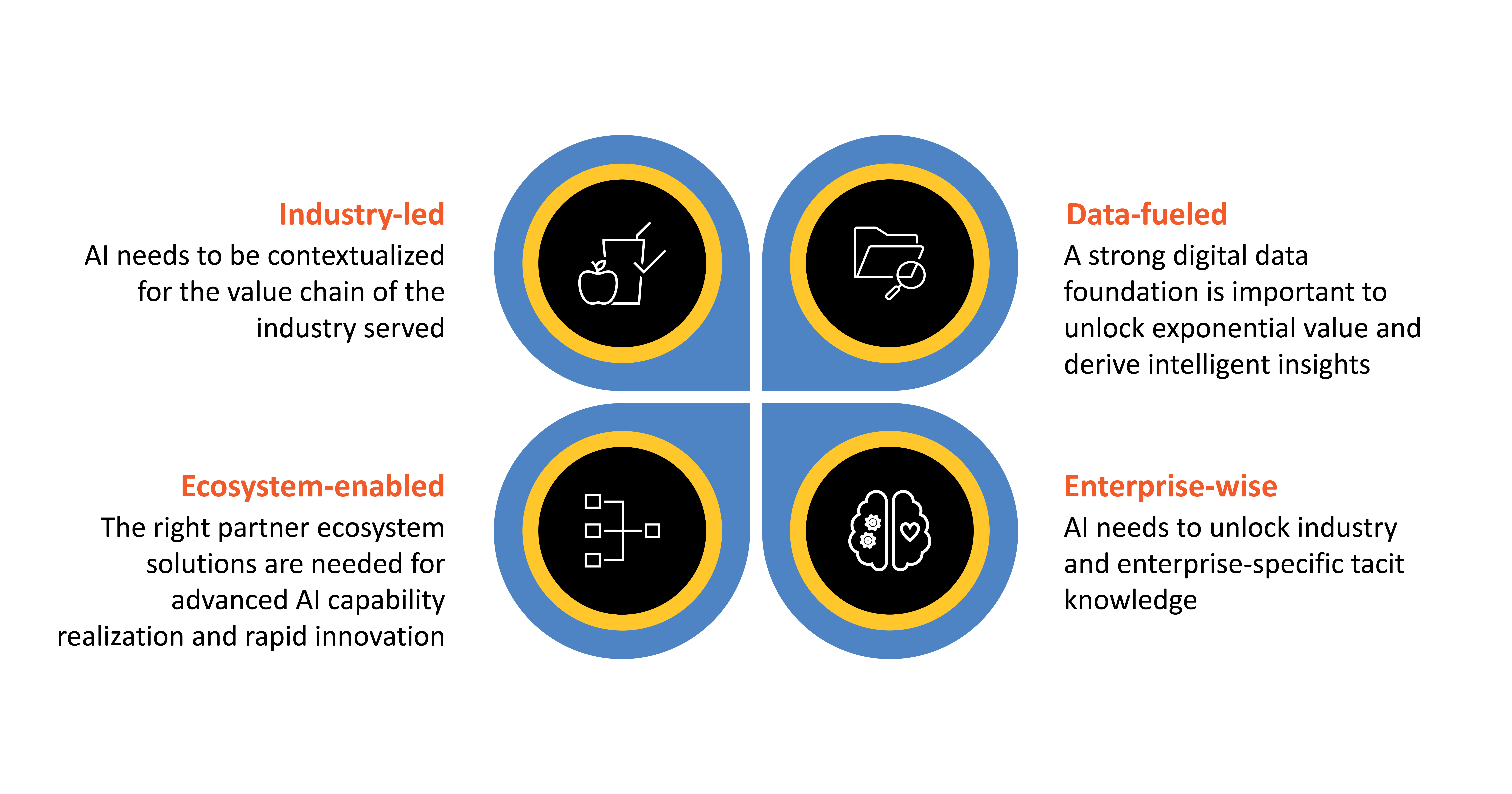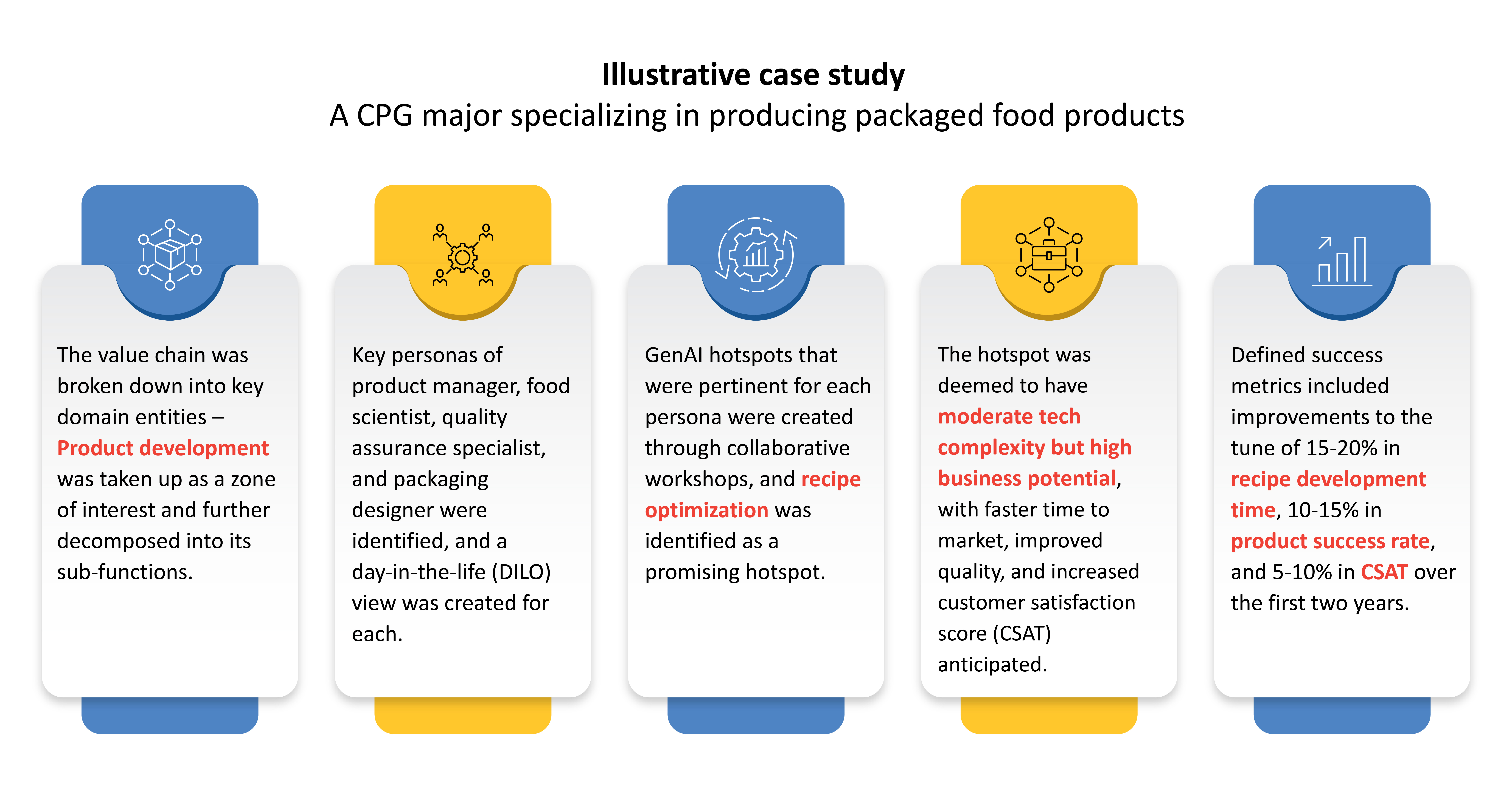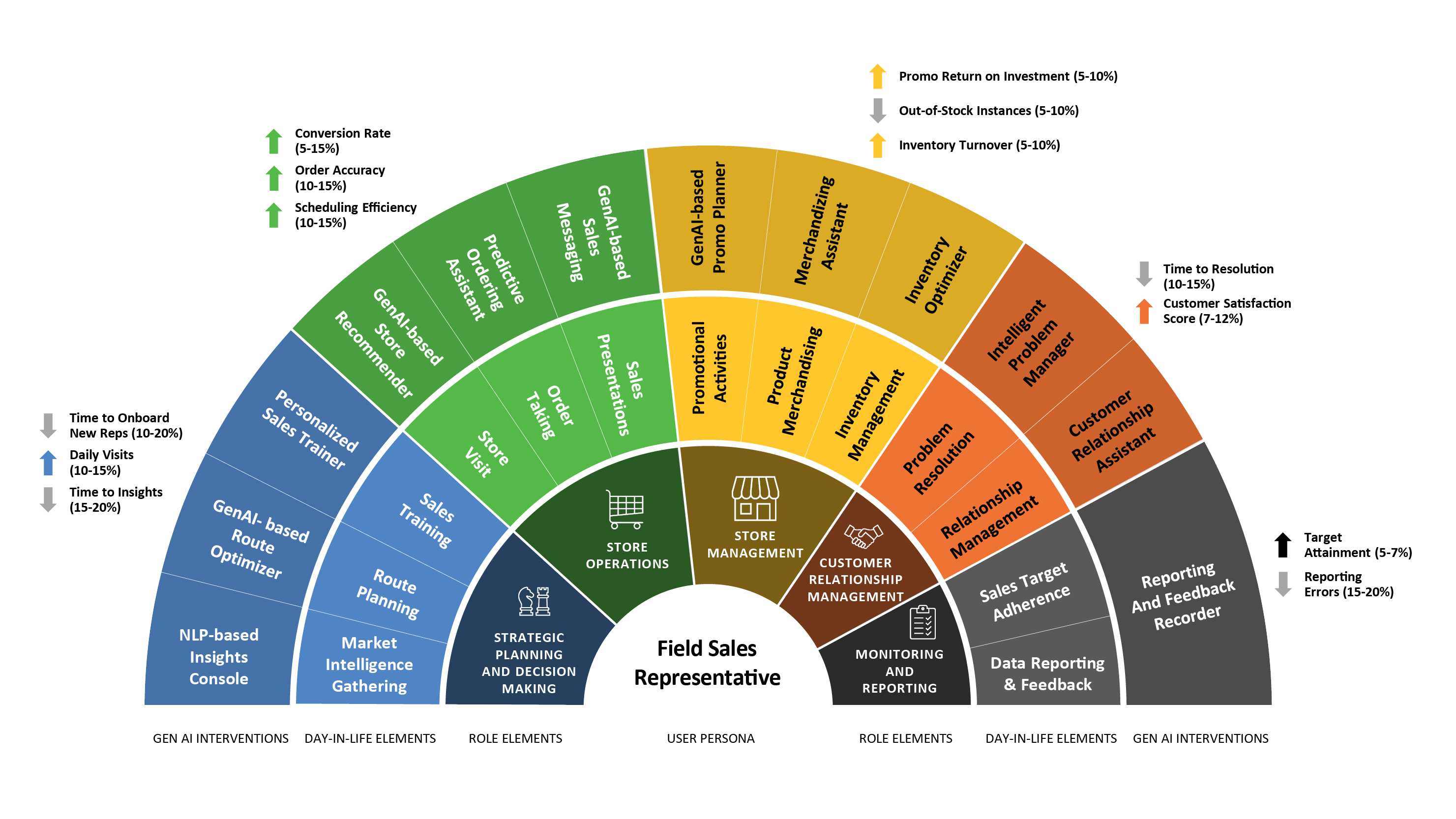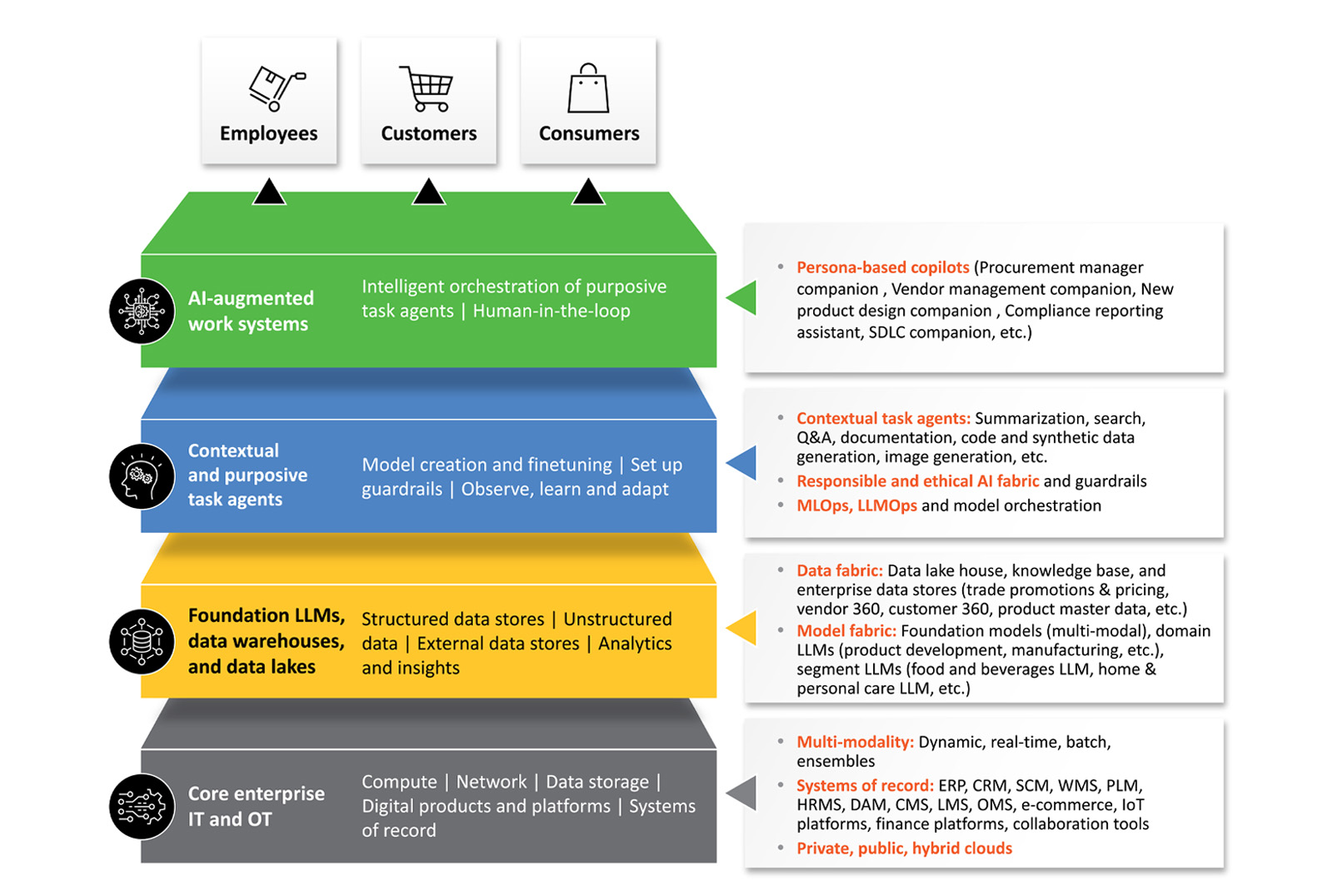INDUSTRY
Highlights
- In the CPG value chain, the true potential of generative AI (GenAI) lies in the areas of operational and tacit knowledge concentration.
- CPG firms must have a well-designed value exchange framework to identify high knowledge concentration hotspots, target the right personas for enablement, and articulate business cases in quantifiable terms to get the most out of GenAI.
- Built on the principles of an industry-led, data-fueled, and ecosystem-enabled foundation, TCS offers an ’enterprise-wise’ AI approach for CPG that leverages artificial intelligence (AI) for an enterprise-grade transformation while balancing the benefits and risks.
On this page
The AI adoption conundrum for CPG
With the rise of e-commerce and disruptive digital technologies, CPG companies are no longer operating in relatively stable market environments.
Due to evolving consumer preferences and expectations, they are facing pressures to innovate, differentiate their offerings, and stay relevant in an increasingly digital marketplace.
Artificial intelligence (AI) offers tremendous potential to help companies reimagine entire value chains and transform the way they do business. However, the latest TCS AI for Business Study reveals that a vast majority of CPG companies have a long way to go to realize these outcomes. Only 5% of CPG leaders affirm that AI has been a differentiating factor for business transformation. In 30% cases, the needle has not moved beyond initial AI exploration, while another 32% are still cleaning up their data and migrating to the cloud.
The slower and less democratized AI adoption in the CPG industry can be traced to several barriers – data fragmentation, regulatory compliance, legacy systems, and scalability challenges.
A fragmented data landscape: A fragmented data landscape with multiple sources (sales data, customer feedback, supply chain information) has differing structures, formats, schema, and storage mechanisms, making integration costly and challenging. Data silos within business groups further hinder enterprise-wide information flow.
Untapped intelligence from unstructured data: Untapped intelligence from unstructured data is challenging to access due to fewer consumer touchpoints compared to retail, limited update cadence, granularity, and customization in syndicated data and the high cost of processing large volumes of unstructured data.
Too many proofs of concept (PoC), too little to show: CPG organizations struggle to transition numerous proofs of concept (PoC) to production due to insufficient tooling and architecture, increased operational complexities during scaling, unaccounted market diversities, and difficulty obtaining timely buy in from business stakeholders as well as the CIOs and CTOs of organizations for AI success.
Our vision: Changing the narrative through GenAI
GenAI expands the arc of AI systems from one of reasoning intelligence to one of operative intelligence.
And that democratizes access to AI capabilities for all, enhances agility, and augments other AI systems as well as human capabilities, unlocking new performance and value frontiers.
As GenAI is still in its infancy, CPG companies face the challenge of balancing investment risk with impact. They are trying to decide whether an incremental use case-driven approach is best or whether the opportunity to gain a competitive advantage will be lost by not placing a bigger bet on the technology.
Focus on areas with significant knowledge concentration
To formulate the right GenAI adoption strategy, firms must first acknowledge that within the CPG value chain, the true potential of GenAI lies in the areas of significant tacit and operational knowledge concentration.
Operational knowledge concentration involves repetitive, narrow, tasks performed variably by many employees, such as data entry and context-switching, which can be automated or augmented with GenAI applications to enhance efficiency and optimize costs. Tacit knowledge concentration, on the other hand, occurs when a few key experts possess business-critical knowledge from experience. This expertise, often found in areas like marketing, product development, and strategic management, can be democratized by digitizing tacit knowledge through GenAI applications, reducing dependence on experts. This allows all knowledge workers, regardless of experience, to leverage formalized knowledge for superior outcomes and innovative breakthroughs.
For example, many product managers rely on heuristics and past successes for positioning, pricing, and channel decisions. GenAI can enhance their strategic decision-making by providing recommendations based on enterprise-specific or broader contextual information, enabling more effective product positioning in various market conditions. Similarly, help desk agents use tacit knowledge to address individual customer needs despite automated support. GenAI can enhance this by providing a continually updated knowledge base, enabling contextualized responses and improved problem resolution.
Transforming GenAI’s potential into sustained value delivery requires a multidimensional strategy and a customized enterprise architecture optimized for cost, quality, and security. Built on the principles of an industry-led, data-fueled, and ecosystem-enabled foundation, we outline a best practice-based ‘enterprise-wise’ AI approach designed to make AI consumable for an enterprise-grade, risk-mitigated, and sustainably successful transformation (see Figure 1).
These four principles underpin the TCS path of AI potential to performance, a continuum that builds upon and reinforces the previous stage: assist, augment, transform (see Figure 2).
In the early stages, most enterprises find themselves in the assist or augment stages. Due to constant AI evolution and foreseeable headwinds around responsible AI and AI-at-scale, many companies are considering phasing out the realization of aspirational AI-first enterprise capabilities to longer time horizons.
Strategic contextualizing of GenAI for the CPG value chain
Many CPG companies have started experimenting with GenAI in the form of a bottom-up, use-case driven approach through proofs of concept (PoC). However, without the foundation of a well-designed framework, this approach is unlikely to be sustainably impactful, resulting in implementation fatigue, risk proliferation, and difficulty in measuring holistic impact.
To maximize business value and return on investment (RoI), GenAI should be considered in the broader context of the overall CPG value chain. Our value exchange mapping framework (see Figure 3) helps CPG companies in their GenAI adoption journey. It allows enterprises to identify areas of high knowledge concentration, target the right personas to act as human agents, and pick the right focus areas, translating to a greater multiplier effect.
Value chain decomposition into domain entities: The process begins with the segregation of the CPG value chain into functional towers (sales, marketing, supply chain and so on) and their sub-functions.
Persona mapping and day-in-a-life articulation: Next, key personas within these functions are identified, and a day-in-life view is created for each, detailing their responsibilities, tasks, challenges, and dependencies.
GenAI hotspots and intervention overlay: The framework identifies GenAI hotspots for significant intervention opportunities, then outlines relevant interventions for each, targeting efficiency, productivity, and effectiveness improvements.
Hotspot evaluation matrix: The matrix charts technical complexity and potential business impact for each intervention, enabling CPG stakeholders to identify investment areas and develop a tailored use case activation roadmap.
GenAI value articulation: Finally, the framework establishes the value proposition for each GenAI intervention using proof-of-value metrics from an extensive bank of key performance indicators (KPI), covering outcome, functionality, and differentiation, while considering the definition of minimum viable product (MVP), technical debt, industrialization, risk, governance, and change management.
The following case study (see Figure 4) showcases the value exchange mapping framework in action.
Powering the CPG value chain of the future with GenAI
GenAI presents opportunities for implementation across the CPG value chain. As potential GenAI uses continue to explode, we believe that truly transformative value will be achieved as organizations advance their use of GenAI from knowledge discovery to personalized augmentation.
We have created over 500 GenAI hotspots aiming to serve more than 150 personas across 12 CPG functional towers, with domain-contextual GenAI solutions driving critical performance and value gains. Figure 5 illustrates a case in point, focusing on the field sales executive persona from the sales function.
In this illustration, we see examples of operational intelligence being extracted, summarized, and democratized in an accessible and localized format, enhancing the efficiency and effectiveness levels of field sales workflows.
Our GenAI journey
The advent of GenAI is an inflection point for CPG companies, reshaping the contours of what is possible.
This is an appropriate juncture to look back at the key takeaways from our journey GenAI so far.
- LLMs are not fact tellers, but storytellers: Traditional AI-ML systems may be a more robust source of truth. But LLMs excel in conveying complex information through compelling narratives that demystify AI models, accelerating their wider adoption.
- Use cases are easy, business cases are difficult: As GenAI use cases proliferate, CPG businesses are finding it ever more difficult to create compelling business cases. This is driven by strategic non-alignment between the supply and demand sides of the CTO organizations, and business groups. Companies are also often lacking the requisite toolkit to establish GenAI program success, making it difficult to measure ROI and create a business case.
- Proofs of concept are easy, scaled production is complex: Many CPG companies are finding out that success in the controlled environment of a proof of concept (PoC) is no guarantee for success in scaled productionization. They face challenges like data harmonization gaps and high latencies.
- Don’t put all eggs in one basket: GenAI technologies, especially LLMs, will rapidly mature and diversify into a marketplace of numerous pre-trained models, offering diverse features. It is difficult to predict how the LLM landscape will evolve, necessitating present GenAI investments to be safeguarded through diversification across a well-curated portfolio of currently available LLMs.
- GenAI and LLMs are just one piece of the AI puzzle: GenAI and LLMs are here to complement and build upon existing AI and related technologies, not replace them. Our research and engagements have underscored the need for a ‘composite AI’ framework – a comprehensive AI approach, where GenAI is embedded into existing solutions or combined with classical AI and related technologies wherever there is scope of complementary, cost-effective, and holistic value generation.
Our recommendations: For successful enterprise-wide GenAI adoption, CPG companies must navigate the delicate balance of opportunity and risk and delivering successful business outcomes (see Table 2).
In our view, getting these elements right is foundational for creating an AI-first business architecture. Built upon the principles of industry-led initiatives, ecosystem collaboration, and cloud-based infrastructure (see Figure 6), AI-first business architectures would scale outcomes, enabling CPG organizations to leverage overall AI (traditional and generative) potential for reshaping value chains and operational methodologies.
The way forward
It is clear that GenAI offers CPG companies an unprecedented opportunity to realize the transformative value of becoming knowledge-driven enterprises.
This will require striking a fine balance between aiming for quick wins versus laying a long-term strategic foundation. A tailored approach to GenAI integration, considering the specific needs and capabilities of each enterprise, is essential for maximizing its benefits across the value chain. GenAI has the potential to transform CPG organizations by augmenting human capabilities, enhancing productivity, and delivering next-gen experiences.
The TCS advantage
Our strong partnerships help CPG organizations successfully navigate GenAI transformations to drive sustained performance.
Deep domain and contextual expertise: TCS has a vast pool of experienced industry experts, with contextual knowledge across CPG functions, to help identify, build, and support the latest and fittest solutions and technologies for clients.
Cross-industry experience: Today’s businesses are more interconnected than ever before and need cross-industry expertise and leading practices. Working with customers across industries such as consumer packaged goods (CPG), travel and transportation, retail, and manufacturing brings an end-to-end holistic view of enterprise business functions and know-how.
Enterprise AI at scale: TCS enables AI at scale through over 150,000 trained associates for more than 670 customers.
Partner ecosystems: Scale and accelerate the path to value through a network of joint solutions and established hyper-scaler partnerships, an elaborate TCS COIN™ network, and co-innovation facilities such as TCS Pace Port™.
Research and innovation focus: TCS collaborates with global academia across AI research areas such as advanced natural language processing (NLP), behavior modelling, and quantum computing.
Evolving solutions: To help accelerate their journey, TCS leverages its contextual knowledge and expertise to enable multiple purpose-built solutions for CPG enterprises that incorporate GenAI technologies.
Key contributors
Subhodeep Banerjee
Global Head, GenAI Practice,
Consumer Goods and Distribution, TCS
Avik Sarkar
Solutioning Head, GenAI Practice,
Consumer Goods and Distribution, TCS
EXECUTIVE CHAMPIONS
Sudhakar Gudala
Senior Vice President and Global Head,
Consumer Goods and Distribution, TCS
Siva Ganesan
Senior Vice President and Head,
AI.Cloud, TCS
Subramanian Balasubramanian
Global Head, CPG Strategic Initiatives and Unit CTO,
Consumer Goods and Distribution, TCS
Nidhi Srivastava
Vice President and Head of Offerings,
AI.Cloud, TCS











